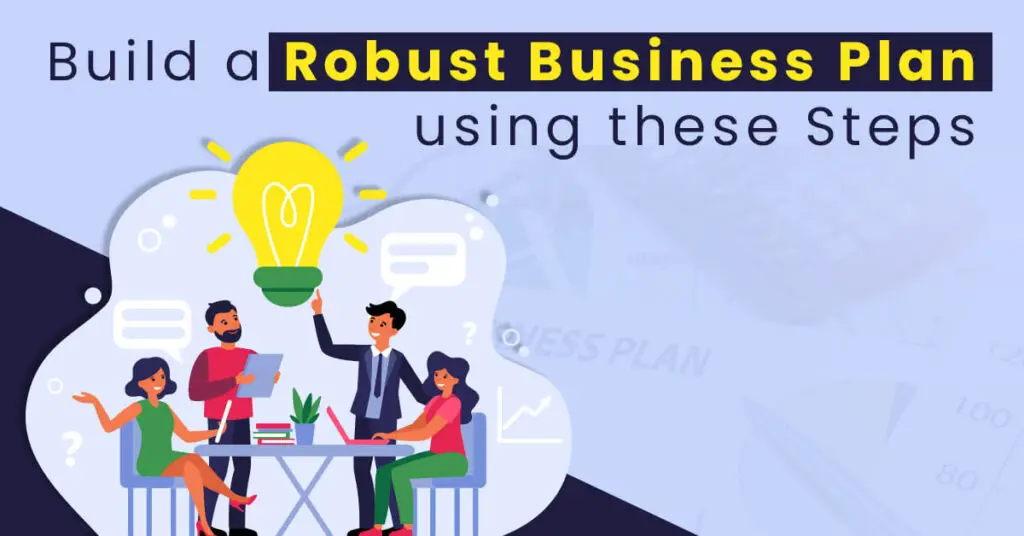Every startup needs a robust business plan to achieve success. A good business plan will guide a business through the many troughs and turns that a business goes through. A startup can use a business plan as a roadmap to form, run and grow its business. A business plan helps you think through the business’s key elements. One of the major reasons startups need a website is that a website instills confidence amongst the people who come to know about a business. A business plan does something similar in nature.
A robust business plan will help a startup get funding or even bring in new business partners. The potential investors of your business will need to feel confident about your venture. A good business plan will give confidence, as it will let the investors know that you have thought through all the aspects of the business.

6 Proven Steps to Create a Startup Business Plan in 2022:
You need to follow certain important steps to build a robust business plan. We will now look at the important steps that will aid a startup to build a successful business plan.
1. Outline the Executive Summary
The executive summary will provide a bird’s-eye view of the entire business plan. When you write the executive summary, ensure that it is simple and precise. Begin the executive summary by showing the core customer needs and how you will solve them.
a) Overview
Explain in brief what the company is about, the company’s location, the customers, and the product/service that you will provide.
b) Employee and Management Profile
Briefly explain the management structure, the people who will be working together, the prior experience and skill set that these people bring to the table.
c) Products and Services to Be Sold
Explain the type of products and services you will sell in this section.
d) Market Research
Explain in brief the market research you have done and how your product or service will fit in the market.
It’s helpful to write the executive summary after you have finished writing the business plan. This way, you can easily identify the key takeaways from your business plan.
e) Financial Considerations
In this section, explain how you will procure funding, how much funding will be required to start the business, and the running utility, and reimbursable expenses of the business. You should also include the amount of money that your business can generate so that the investors can have a clear idea about the returns they can get by investing in your business.
f) Identify Target Market
Identifying the target market is one of the most important steps that one needs to take to ensure that resources are not squandered running after every customer. Understand that your business isn’t for everybody, and customer targeting will help you quickly gain a bigger market share.
Countless startups fail because they fall in love with an idea and start the business without actually ascertaining whether there is a big enough market for the idea. Don’t fall into tunnel vision and conduct proper market research to identify the most appropriate target customer segment.
Start with broad assumptions about the target market, conduct research around these assumptions, and narrow down your range of target customers.
You can segment the market based on the following factors.
- Age
- Gender
- Location
- Income level
- Ethnicity
You will have an ideal customer profile once you conduct a proper market analysis. For instance, a customer who lives in New York, in the age bracket of 25-40, spends a decent amount of money on coffee can be a good customer for people who want to open a coffee shop in New York City.
When discussing the target customer, always include the data you analyzed to reach this inference.
See Also: The Role of Technology in Business Growth
2. Analyze Your Competition
In addition to target market research, you will also need to conduct a robust competitive analysis before starting your business. Competitive analysis will boost your confidence by identifying the areas where your competitors are strong and the areas where they are weak.
This way, you can discover an unmet need of the market that your competitors cannot fulfill. When you do competitor analysis, ensure that you do not blindly copy a successful competitor’s business model. This is because the customers would not have any reason to switch to your brand if there already is a business that the customers know and trust.
Differentiate your business from competitors by either offering a lower price or a better quality. Make sure to do a competitive analysis for the same target market that you want to focus upon. For instance, the target market for Ford Motors will be different from that of a Ferrari.

3. Budget and Financial Projections
Get your numbers to write the business plan to ensure that your startup does not suffer from funding issues. Figure out how much money you will require to start the business and the money required to run the operations.
When you prepare the budget, take the costs for expenses like:
- Property cost (buying or leasing costs)
- Equipment costs
- Legal fees
- Insurance
- Marketing expenses
- Salaries of employees
- Utilities like electricity, internet and telephone bills
- Domain hosting and other expenses to keep the website, app or both up and running
- Inventory costs
A pro tip is to estimate higher; things won’t always go according to your plan.
You will need financial projections to ensure the financial viability of the project. Financial projections will help you secure investor funding as all investors will be interested in their ROI (return on investment). Start by estimating the total number of customers in your target market and then zero in the percentage of market share that you can gain. Outline your expansion plans in your financial projections.
Do not over the plan, but always base your financial projections for the first 3-5 years of your startup and make sure that the projections are reasonable. Be honest with your potential investors and, more importantly, yourself to ensure that you deliver what you have promised.
You May Like: How to Avoid Budget Hazards For Better Financial Future
4. Describe the Products and Services
In this section, you will describe the product or service you are offering. When you provide the product or service details, ensure that you highlight the link between what you are offering and what people need. This way, you can prove a market for your products/services.
Before you zero in on the product and service you want to sell, conduct some face-to-face market research. Ask the potential customers about the problems they face currently and how a product and service can help solve this problem. When you ask for the customers’ opinion, ensure that you do not try to fit the customers’ answers according to your product. Instead, look for honest opinions of the customers and make the necessary changes to your product or service if necessary. Understand that it makes more sense to create a product for an existing problem instead of finding a problem for your product.
Once you have researched the customers’ problems, identify the most important and common problems faced by a majority of the customers. Describe how your product or service will be the ultimate solution for these problems.
If there is a feature missing in the existing products or services, then you can include this feature in your product or service. If the existing solutions are expensive, you can offer the product or service at a discount to lure customers. This section will show how your product or service can prove to be an enticing value proposition. If a mobile app is your product or service, you will find our mobile app development guide useful.

5. Define Management Roles
No startup can succeed without strong management. The people who run the business must have the required expertise and experience. Under this section, you will need to outline the organizational structure of your startup. Decide the management roles, who will be responsible for what, the hierarchy of management, and how you will assign the tasks and responsibilities to each person.
When you define management roles, give a brief introduction regarding the experience and skill set of key management personnel like the CEO (chief executive officer), the CMO (chief marketing officer), the CFO (chief financial officer), the hiring manager, and the founders. Please include any relevant experience and education to instill confidence amongst the investors that the people you have brought together are the best fit for their respective jobs.
If you haven’t hired people for the planned roles yet, then make sure that you identify the skill set and the experience level required in the people for these roles. This way, you will be able to present a picture of clarity to potential investors that you know what kind of people you need for what type of roles.
See Also: How Do You Ensure Safety and Security of Employees?
6. Prepare a Sales and Marketing Strategy
This is the section where you need to show a comprehensive marketing and sales strategy for your startup. The marketing and sales strategy will cover how you plan to sell your product. Your work on creating ideal buyer personas, competitive analysis, and target market analysis will prove helpful during this stage.
To devise an effective marketing strategy, you will need to answer questions like;
- How will you penetrate the target market?
- Which places do your customers frequently visit(both online and offline)?
- The channels to focus on for distribution?
- The mode of communication with your customers?
The following questions will help you devise an effective sales strategy:
- What will be the structure of your sales team?
- What will be your sales strategy?
- How have you planned to scale for growth?
- What is the average price per sale?
Ensure to include specifics like to what extent you will use social media for marketing, whether you will use paid apps for promotion, or go for organic promotion in your marketing strategy. Similarly, in your sales strategy, mention the expected sales from each channel and the reasoning behind it. Answer the questions mentioned above to develop an effective sales and marketing strategy.
You May Like: How Do You Make a Good Marketing Brochure?
Conclusion
We know how exciting it is to launch a startup. It’s very easy to lose sight of the big picture and get caught up in the moment. If you want to ensure success, then plan things out, and a business plan would ensure that you can do so.
If you want to set yourself up for the success you deserve, you need to take a step back and work on creating better plans. While writing a business plan may seem like a tedious task right now, note that it will keep you organized and save you lots of headaches down the road.





